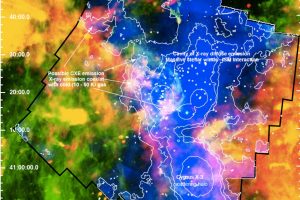Diffuse X-ray emission in massive star formin region. Published on ApJS “Diffuse X-ray emission in the Cygnus OB2 association” of J. F. Albacete-Colombo (Universidad de Rıo Negro)

During their short existence lasting only few million years, massive stars (more massive than 8 solar masses with spectral type O and B-early) strongly affect the surrounding environment thanks to their intense UV radiation and stellar winds. A single O star, in fact, can loose about 10-6 solar masses of gas in a wind reaching velocities of 1600–2500 km s−1 (Stevens & Hartwell, 2003).
Both in our Galaxy and nearby galaxies such as the Magellanic Clouds, we have identified several massive star forming regions hosting tens to hundreds of massive stars. Their violent winds can collide or produce shocks in the intra-cluster medium (gas and dust populating the cluster), triggering interesting and energetic phenomena. For instance, the dissipative shocks in the intra-cluster medium can deposit large amount of energy in it, rising gas temperature and producing intense diffuse X-ray emission.
Diffuse X-ray emission has been found in few star forming regions in our Galaxy: The Rosetta and Omega Nebulae (Muno et al. 2006), the Orion Nebula (Gudel et al. 2008), and the Carina Nebula (Tonwsley et al. 2011). In the study “Diffuse X-ray emission in the Cygnus OB2 association” of J. F. Albacete-Colombo (Universidad de Rıo Negro, Argentina), accepted for publication by the Astrophysical Journal Supplement with the collaboration of the astronomers E. Flaccomio, M. G. Guarcello, G. Micela e S. Sciortino of the Astronomical Observatory of Palermo, diffuse X-ray emission is found and analysed in the massive association Cygnus OB2. The discovery has been possible thanks to the Chandra observations of the region part of the Chandra Cygnus OB2 Legacy Project, led by J. J. Drake of the Harvard Smithsonian Center for Astrophysics (USA) and with a strong participation of the Astronomical Observatory of Palermo. After removing from the images about 8000 sources observed, the authors have identified the presence of diffuse X-ray emission, with a luminosity of 4.2×1034 erg/sec in the 0.5-7 keV band, filling the cavity in the cloud hosting the association. This emission arises from dissipative shocks in the intra-cluster medium and wind-wind collisions, which heat the gas up to million degrees. The authors, in fact, have identified three main thermal components in the medium at 1.2, 4.9, and 15 million degrees.
The figure (link) shows the Cygnus OB2 region in infrared (marking the cloud emission) with the diffuse X-ray emission filling its cavity.
